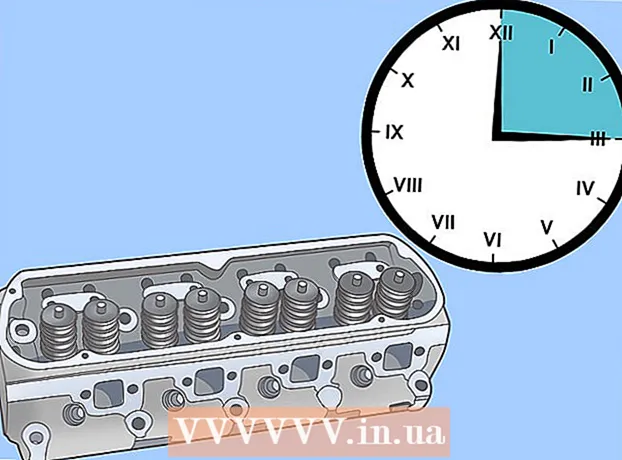Author:
Gregory Harris
Date Of Creation:
16 August 2021
Update Date:
1 July 2024

Content
- Steps
- Part 1 of 2: Calculating Water Density
- Part 2 of 2: Theory and Practical Application
- Warnings
- What do you need
Density is the ratio of body weight to the volume occupied by this body. The metric unit of density is kg / m or g / cm, that is, it indicates the mass of one cubic meter or centimeter of a substance. Finding out the density of water is quite simple using the formula density = mass / volume.
Steps
Part 1 of 2: Calculating Water Density
 1 Gather the required materials. To calculate the density of water, you need a graduated cylinder, balance and water. A graduated cylinder is a special container with notches or marks in which an accurate volume of liquid can be measured.
1 Gather the required materials. To calculate the density of water, you need a graduated cylinder, balance and water. A graduated cylinder is a special container with notches or marks in which an accurate volume of liquid can be measured.  2 Weigh the empty graduated cylinder. To find out the density, you need to know the mass and volume of the liquid that interests you. Using a graduated cylinder, you can find out the mass of water, but you also need to subtract the mass of the cylinder itself in order to use only the mass of water poured into it.
2 Weigh the empty graduated cylinder. To find out the density, you need to know the mass and volume of the liquid that interests you. Using a graduated cylinder, you can find out the mass of water, but you also need to subtract the mass of the cylinder itself in order to use only the mass of water poured into it. - Turn on the balance and make sure it is set to zero.
- Place a dry and empty graduated cylinder on the balance.
- Write down the mass of the cylinder in grams.
- Suppose an empty graduated cylinder weighs 11 g.
 3 Pour water into the graduated cylinder. Add any amount of water, but remember to write down the exact value. Look at the cylinder at eye level and record the volume at the bottom of the meniscus. A meniscus is a curvature of the surface of a liquid that can be seen when looking exactly at eye level.
3 Pour water into the graduated cylinder. Add any amount of water, but remember to write down the exact value. Look at the cylinder at eye level and record the volume at the bottom of the meniscus. A meniscus is a curvature of the surface of a liquid that can be seen when looking exactly at eye level. - The volume of water in the graduated cylinder will be used to calculate the density.
- Suppose you have poured 7.3 ml of water into a graduated cylinder (this is the same as 7.3 ml).
 4 Weigh the graduated cylinder with water. Make sure the balance is at zero to weigh the graduated cylinder with water. Be careful not to spill water from the cylinder when weighing it.
4 Weigh the graduated cylinder with water. Make sure the balance is at zero to weigh the graduated cylinder with water. Be careful not to spill water from the cylinder when weighing it. - If you do spill water, record the new volume and re-weigh the cylinder with water.
- Suppose a graduated cylinder filled with water weighs 18.3 g.
 5 Subtract the weight of the empty graduated cylinder from the weight of the water cylinder. To find out the mass of the water itself, you need to subtract the mass of the graduated cylinder. As a result, only one mass of water remains in the cylinder.
5 Subtract the weight of the empty graduated cylinder from the weight of the water cylinder. To find out the mass of the water itself, you need to subtract the mass of the graduated cylinder. As a result, only one mass of water remains in the cylinder. - In our example, the mass of the measuring cylinder is 11 g, and the mass of the cylinder with water is 18.3 g. 18.3 g - 11 g = 7.3 g. Therefore, the mass of water is 7.3 g.
 6 Calculate the density of the water by dividing mass by volume. Use the formula density = mass / volumeto find out the density of the water. Substitute the obtained values for mass and volume.
6 Calculate the density of the water by dividing mass by volume. Use the formula density = mass / volumeto find out the density of the water. Substitute the obtained values for mass and volume. - weight of water: 7.3 g;
- water volume: 7.3 cm;
- density of water = 7.3 / 7.3 = 1 g / cm.
Part 2 of 2: Theory and Practical Application
 1 Find out the definition of the equation for calculating the density. Density will be equal to body weight mdivided by body volume v... Density is indicated by a Greek letter ρ (ro). A denser body will have a greater mass with a smaller volume compared to other bodies of lower density.
1 Find out the definition of the equation for calculating the density. Density will be equal to body weight mdivided by body volume v... Density is indicated by a Greek letter ρ (ro). A denser body will have a greater mass with a smaller volume compared to other bodies of lower density. - Standard formula for calculating density: ρ = m / v.
 2 Use the correct units for each variable. When calculating density, metric units are used. Body weight is expressed in grams or kilograms. Body volume - in cubic centimeters or meters.
2 Use the correct units for each variable. When calculating density, metric units are used. Body weight is expressed in grams or kilograms. Body volume - in cubic centimeters or meters.  3 Understand why density is needed. Body density can be used to identify various materials. If you want to identify a substance, then you can calculate the density and compare with the known density of different materials.
3 Understand why density is needed. Body density can be used to identify various materials. If you want to identify a substance, then you can calculate the density and compare with the known density of different materials.  4 Be aware that there are factors that can affect the density of the water. The density of water is practically equal to 1 g / cm, but in some scientific disciplines it is necessary to know the most accurate value of the density of water. The density of pure water varies with temperature. The lower the water temperature, the higher the density.
4 Be aware that there are factors that can affect the density of the water. The density of water is practically equal to 1 g / cm, but in some scientific disciplines it is necessary to know the most accurate value of the density of water. The density of pure water varies with temperature. The lower the water temperature, the higher the density. - For example, at 0 ° C the density of water is 0.9998 g / cm, but at 80 ° C it is already 0.9718 g / cm. The difference may sound small, but it can be significant for scientific research and experimentation.
Warnings
- Be careful not to break the glass graduated cylinder. Broken glass is sharp and there is a risk of cutting yourself.
What do you need
- Water
- Measuring cylinder
- scales



